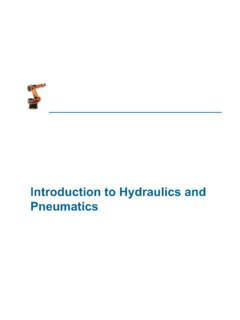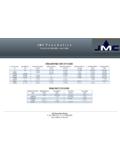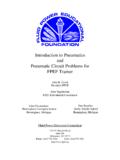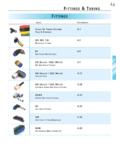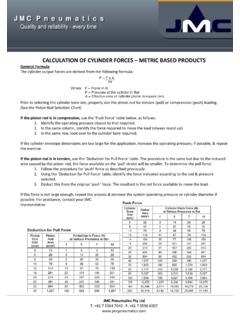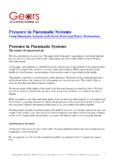Transcription of Unit 24: Applications of Pneumatics and Hydraulics
1 1 Unit 24: Applications of Pneumatics and Hydraulics Unit code: J/601/1496 QCF level: 4 Credit value: 15 OUTCOME 2 TUTORIAL 3 hydraulic AND pneumatic MOTORS The material needed for outcome 2 is very extensive so there are ten tutorials in this outcome. You will also be completing the requirements for outcome 1 which is integrated into it. The series of tutorials provides an extensive overview of fluid power for students at all levels seeking a good knowledge of fluid power equipment. 2 Understand the construction, function and operation of pneumatic and hydraulic components, equipment and plant pneumatic equipment: types, construction, function and operation air compressors, coolers, dryers, receivers, distribution equipment, fluid plumbing and fittings, drain traps, FRL air service units, valves, actuators, seals hydraulic equipment: types, construction, function and operation fluids, pumps, motors, actuators, reservoirs, accumulators, fluid plumbing and fittings, valves, filters, seals, gauges Performance characteristics: air compressors volumetric efficiency, compression ratio, isothermal efficiency.
2 hydraulic pumps operating efficiency, losses, flow rate, operating pressure, shaft speed, torque and power The series of tutorials provides an extensive overview of fluid power for students at all levels seeking a good knowledge of fluid power equipment. On completion of this tutorial you should be able to do the following. Explain the working principles of a range of hydraulic motors. Describe the construction of motors. Explain the principles of a range of semi rotary actuators Define the nominal displacement. Explain the relationship between low rate and shaft speed. Define fluid power and shaft power. Define and explain volumetric and overall efficiency. Solve problems involving power, torque and flow rate. Describe the seals and drainage used in motors.
3 Recognise and draw the symbols for motors and rotary actuators. 2 ROTARY MOTORS 1. GENERAL THEORY The purpose of a rotary motor is to convert fluid power into shaft power by forcing the shaft to rotate. Pressure is converted into torque and flow rate is converted into speed. In other words, the faster you push the fluid through the motor, the faster it goes and the harder it is to turn the shaft, the higher the pressure needed to make it go round. Figure 1 2. SYMBOLS Figure 2 The basic symbol is a circle with a triangular arrow pointing inwards indicating the direction of flow. pneumatic symbols have white arrow and hydraulic symbols have black arrows. 3 3. DETAILED THEORY Air is a very compressible substance and the theory for air motors is more complicated than for hydraulic motors.
4 The volume of hydraulic fluids is considered constant in the following theory. In other words, the volume is unaffected by the pressure. The following applies to hydraulic motors. POWER AND EFFICIENCY FLUID POWER is defined as = Q p Q is the flow rate in m3/s and p is the difference between the inlet and outlet pressure in N/m2. The output power is the shaft power is given by the formula = 2 NT = T N is the speed in rev/s. T is the shaft torque in Nm and is the shaft speed in radian/s. The output power is reduced because of friction and internal slippage of fluid. This gives the overall efficiency for the motor and this is defined as follows. Overall Efficiency = o = Output/Input = Shaft Power/Fluid Power It must be remembered that in the case of gas as the working fluid, the volume depends upon the pressure.
5 SPEED - FLOW RELATIONSHIP The basic relationship between flow rate and speed is Flow Rate = Q = Kq x Speed Kq is the nominal displacement of the motor usually expressed in units of cm3/rev. TORQUE - PRESSURE RELATIONSHIP In fluid power, shaft speed is normally given in rev/min or rev/s. The formula for shaft power is given by the well known formula SP = 2 NT. If the motor is 100% efficient, the shaft power is equal to the fluid power so equating we get the following. 2 NT = Q p Rearrange to make T the subject. T = (Q/N) p/2 T = kq p/2 p is the difference in pressure between the inlet and outlet of the motor. Kq is the nominal displacement in m3/s. In control theory it is more usual to use radians/s for shaft speed in which case: T = Q p Rearrange to make T the subject.
6 T = (Q/ ) p T = kq p Kq is the nominal displacement in m3/radian. The operating characteristics of an ideal motor may be summed up by the two equations: Flow rate = Kq N T = Kq p 4 VOLUMETRIC EFFICIENCY It is possible for hydraulic fluid to slip forward from the high pressure port to the low pressure port through the clearance gaps around the working elements without doing anything to rotate the shaft. This is called internal slippage and it results in a flow rate larger than the theoretical. Actual flow rate = Ideal Flow rate + Slippage The volumetric efficiency of the motor is defined as: v = Ideal Flow rate/Actual flow rate 4. ROTARY ACTUATORS There is a special motor called a rotary actuator that is designed for slow rotation of less than one revolution but with a large torque.
7 Diagrams of the various designs are shown later. The symbols are shown. These actuators are commonly used on robotic devices. pneumatic actuators are used for simple pick and place operations and for opening and closing pipeline valves. hydraulic actuators are typically used to swing the boom on a mobile excavator from side to side. Figure 3 WORKED EXAMPLE The pressure difference over a hydraulic motor is 80 bar and it runs at 400 rev/min. The nominal displacement is 5 cm3/rev. The overall efficiency is 85% and the volumetric efficiency is 90%. Calculate the following. i. The ideal flow rate. ii. The actual flow rate. iii. The fluid power. iv. The shaft power. v. The shaft torque. SOLUTION N = 400/60 rev/s kq = 5 x 10-6 m3/rev Ideal Flow rate = kq x N = 5 x 10-6 x 400/60 = x 10-6 m3/s Actual Flow Rate = Ideal Flow rate/ v = x 10-6 = x 10-6 m3/s Fluid Power Q p = x 10-6 x 80 x 105 = Watt Shaft Power = Fluid Power x o = x = Watt Torque = SP/2 N = /(2 x 400/60) = Nm 5 SELF ASSESSMENT EXERCISE 1.
8 Calculate the output power of a hydraulic motor which has a flow rate of 5 dm3/s and a pressure difference of 80 bar. The overall efficiency is 75%. (Answer 30 kW) 2. A hydraulic motor must produce an output power of 500 Watts from an oil supply at 50 barg which exhausts at 0 barg. The efficiency is 80%. Calculate the flow rate of oil required. (Answer 125 cm3/s) 3. A hydraulic motor has a flow constant of cm3/rad. Calculate the quantity of oil needed to turn the shaft of a revolution. ( cm3 ) Calculate the speed of the shaft in rev/min when oil is supplied at 20 cm3/s. ( rev/min) 4. The pressure difference over a hydraulic motor is 120 bar and it runs at 200 rev/min. The nominal displacement is 8 cm3/rev. The overall efficiency is 80% and the volumetric efficiency is 85%.
9 Calculate the following: i. The ideal flow rate. ( cm3/s) ii. The actual flow rate. ( cm3/s) iii. The fluid power. ( W) iv. The shaft power. ( W) v. The shaft torque. ( Nm) 5. DRAINAGE and SEALS The hydraulic fluid under pressure may be forced down the shafts and would leak out from the front of the motor. In the first instance a rotary shaft seal is used to prevent leakage. However, sealing it in would result in pressurisation and the shaft seal would be blown out. To prevent this, the shaft spaces are drained to low pressure. In the case of motors with one direction of rotation, the drainage passage may be internally connected to the low pressure side. In the case of motors that rotate either way, there is no permanent low pressure side so a separate drain connection is found on the motor that must be piped back to tank.
10 Figure 4 6 6. MOTOR TYPES hydraulic motors are used to convert hydraulic energy into mechanical energy. They are classified according to the type of internal elements that are directly actuated by the flow of fluid. hydraulic motors are very similar in construction to hydraulic pumps. In fact many pumps may be used as motors without any modification. Like hydraulic pumps most hydraulic motors are classified as gear, vane, piston or deri sine type. Rotary motors are generally rated in terms of DISPLACEMENT or TORQUE. They may be fixed displacement motors or variable displacement motors. Fixed displacement motors normally have constant torque, the speed being varied by altering the flow to the motor. Variable displacement motors have variable torque and speed.










